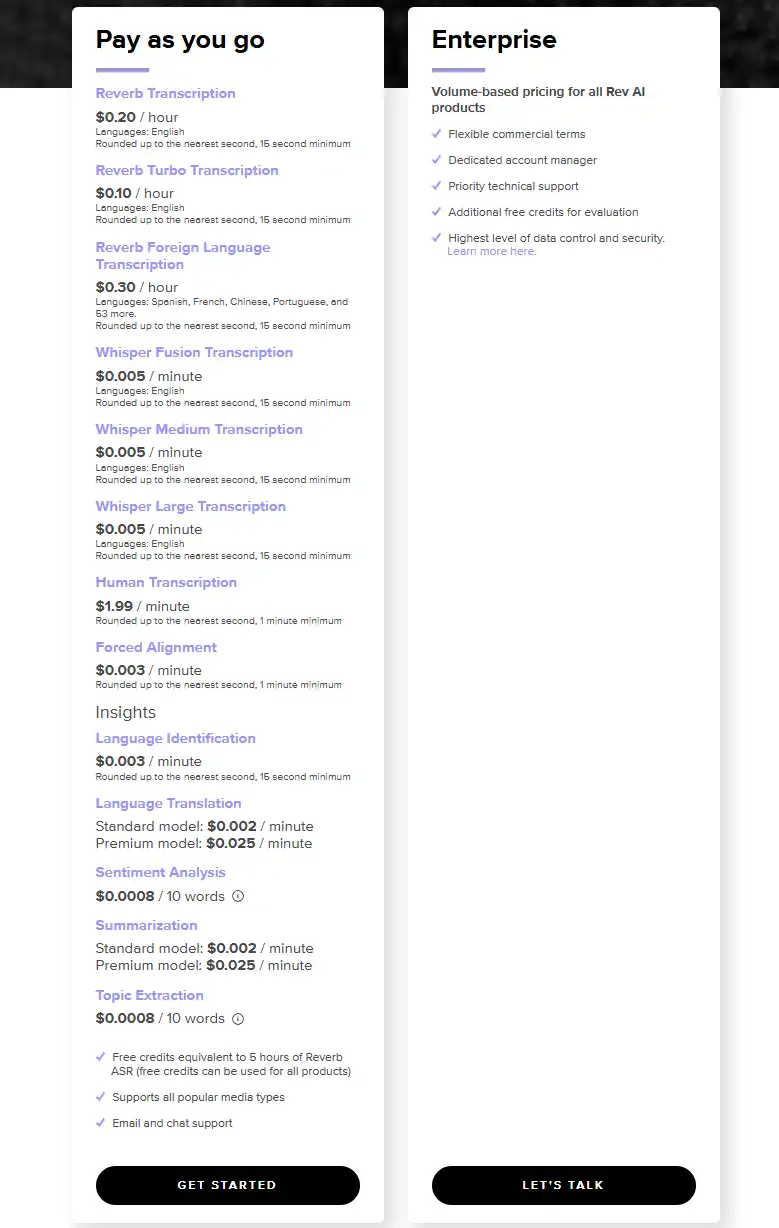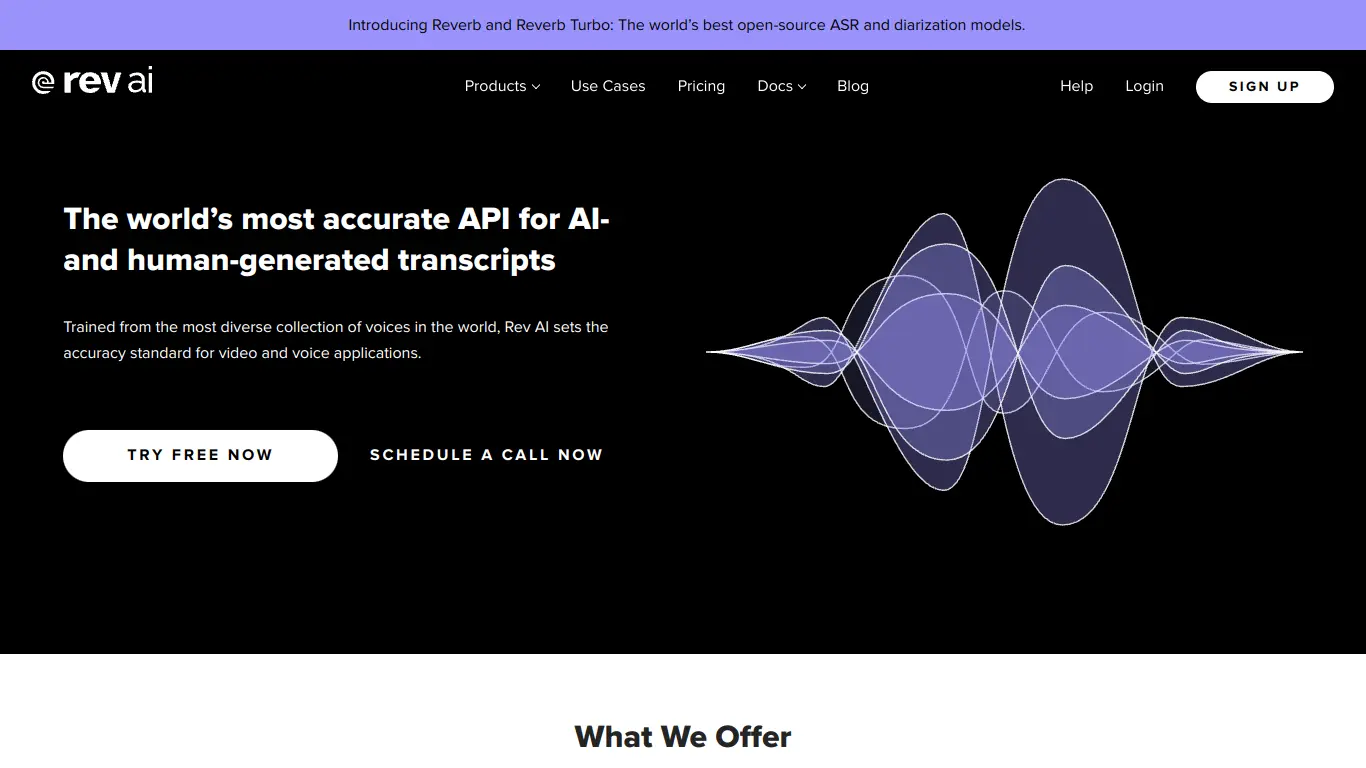Rev.ai is a powerful speech-to-text API with 90%+ accuracy, developer-friendly integration, and flexible pricing for various industries.
Introduction to Rev.ai
Turning speech into text accurately and efficiently is no longer just a convenience—it’s a necessity. Whether you’re a content creator, researcher, or business professional drowning in audio files, Rev.ai emerges as a powerful solution to this common challenge.
What is Rev.ai and its Purpose?
Rev.ai is an advanced speech recognition API platform that converts audio and video content into text with remarkable accuracy. Unlike basic transcription tools, Rev.ai utilizes cutting-edge artificial intelligence and machine learning to deliver industry-leading speech-to-text services. The platform’s core purpose is to provide developers and businesses with powerful speech recognition capabilities that can be seamlessly integrated into their applications, workflows, and services.
The technology behind Rev.ai was developed to address the growing need for accurate, scalable, and customizable speech recognition solutions across various industries. By providing both pre-built solutions and developer-friendly APIs, Rev.ai serves as a bridge between complex audio data and actionable text-based information.
Who is Rev.ai Designed For?
Rev.ai caters to a diverse audience, spanning multiple sectors and user types:
- Developers and Software Engineers: Those looking to integrate speech-to-text capabilities into their applications, products, or services
- Content Creators: Podcasters, video producers, and media companies needing to transcribe their content for accessibility, SEO, or repurposing
- Market Researchers: Professionals who need to analyze interviews, focus groups, and other audio-based research
- Healthcare Providers: Medical professionals requiring accurate transcription of patient notes and records
- Legal Professionals: Attorneys and paralegals who need transcripts of depositions, hearings, and case materials
- Enterprise Businesses: Companies looking to analyze customer service calls, meetings, and other voice communications
- Educational Institutions: Schools and universities that need to provide accessible content for students
This wide range of use cases demonstrates Rev.ai’s versatility as both a developer tool and an enterprise solution.
Getting Started with Rev.ai: How to Use It
Getting started with Rev.ai is straightforward, whether you’re a developer looking to integrate the API or a business user seeking immediate transcription solutions:
- Create an Account: Visit Rev.ai’s website and sign up for an account
- Choose Your Solution: Decide between using the API for integration or the pre-built transcription service
- For API Users:
- Generate an API key from your account dashboard
- Review the comprehensive API documentation
- Choose between asynchronous or streaming transcription based on your needs
- Implement the API using SDK libraries available for Python, Node.js, and other languages
- For Transcription Service Users:
- Upload your audio or video files directly through the web interface
- Select any additional options like speaker diarization (identifying who said what)
- Receive your transcription results, typically within minutes depending on file length
The platform is designed to be intuitive while offering the flexibility and power required for sophisticated applications.
Rev.ai’s Key Features and Benefits
Core Functionalities of Rev.ai
Rev.ai stands out in the speech recognition market due to its robust feature set built around powerful core functionalities:
- Asynchronous Speech-to-Text API: Perfect for batch processing of pre-recorded audio files with a simple RESTful API
- Streaming Speech-to-Text API: Provides real-time transcription for live audio sources
- Speaker Diarization: Automatically identifies and labels different speakers in conversations
- Custom Vocabulary: Allows users to add domain-specific terms to improve recognition accuracy
- Punctuation and Capitalization: Automatically adds proper punctuation and capitalization to transcripts
- Timestamp Generation: Creates precise timestamps for each word in the transcript
- Confidence Scores: Provides confidence ratings for transcribed words to indicate accuracy
- Multi-language Support: Transcribes content in multiple languages and dialects
- File Format Flexibility: Accepts a wide range of audio and video file formats
- Content Filtering: Optional detection and filtering of profanity or sensitive content
These features form the foundation of Rev.ai’s powerful speech recognition platform, enabling it to handle diverse use cases across industries.
Advantages of Using Rev.ai
Rev.ai offers several compelling advantages that set it apart from conventional transcription services:
| Advantage | Description |
|---|---|
| Industry-Leading Accuracy | With over 90% accuracy in most scenarios, Rev.ai consistently outperforms many competitors |
| Developer-Friendly Integration | Well-documented APIs with SDKs for multiple languages make implementation straightforward |
| Scalability | Handles everything from single files to enterprise-level volumes with consistent performance |
| Speed | Processes audio faster than real-time, meaning a 60-minute recording takes less than 60 minutes to transcribe |
| Customizability | Custom vocabulary and model adaptation improves accuracy for specific domains |
| Reliability | Enterprise-grade infrastructure with high availability and robust error handling |
| Privacy and Security | SOC 2 compliance and strong data protection practices safeguard sensitive information |
| Cost-Effectiveness | Pay-as-you-go pricing ensures you only pay for what you use |
These advantages make Rev.ai a preferred choice for organizations seeking reliable, high-quality speech recognition capabilities.
Main Use Cases and Applications
Rev.ai’s versatility shines through its diverse applications across industries:
Content Creation and Media
- Automatically generating subtitles and closed captions for videos
- Creating searchable archives of podcast episodes
- Transcribing interviews for articles and publications
- Enabling content repurposing from audio/video to text formats
Business Intelligence
- Analyzing customer service calls for insights and quality assurance
- Transcribing meetings and conferences for documentation
- Converting voice notes into searchable text
- Monitoring compliance in regulated conversations
Healthcare
- Transcribing patient consultations and medical dictations
- Creating accessible records for patients with hearing impairments
- Documenting medical procedures and clinical trials
Legal
- Transcribing depositions, hearings, and legal proceedings
- Creating searchable archives of case-related recordings
- Ensuring accurate documentation for legal compliance
Education
- Generating transcripts of lectures for study materials
- Creating accessible content for students with disabilities
- Transcribing research interviews and focus groups
Software Applications
- Building voice-controlled interfaces and assistants
- Adding transcription capabilities to productivity applications
- Creating searchable archives in content management systems
These use cases demonstrate Rev.ai’s flexibility and the tangible value it delivers across diverse professional contexts.
Exploring Rev.ai’s Platform and Interface
User Interface and User Experience
Rev.ai offers two distinct interfaces: a developer-focused API dashboard and a user-friendly web interface for direct transcription services.
API Dashboard
The API dashboard provides developers with:
- A clean, organized view of API keys and usage statistics
- Clear documentation with code examples for various programming languages
- Testing tools to validate API calls before implementation
- Usage monitoring and billing information
- Account management features
The dashboard employs a minimalist design philosophy, prioritizing functionality and clarity over flashy elements. This approach suits the technical audience and ensures developers can quickly find the information they need.
Transcription Web Interface
For non-developers using Rev.ai’s direct transcription services, the web interface features:
- A straightforward file upload system with drag-and-drop functionality
- Progress indicators for ongoing transcriptions
- An editor for reviewing and correcting transcripts
- Options for exporting in multiple formats
- Account management and billing features
The web interface strikes a balance between simplicity and functionality, making it accessible to users without technical backgrounds while still providing powerful features.
Platform Accessibility
Rev.ai demonstrates a strong commitment to accessibility across its platform:
Web Accessibility
- The platform adheres to WCAG 2.1 guidelines for web accessibility
- High contrast modes and keyboard navigation are supported
- Screen reader compatibility ensures users with visual impairments can navigate effectively
Cross-Platform Compatibility
- The web interface works seamlessly across desktop and mobile devices
- API endpoints can be accessed from any system with internet connectivity
- SDKs are available for multiple programming languages (Python, JavaScript, PHP, etc.)
Documentation Accessibility
- Technical documentation is comprehensive yet clear, with examples for beginners
- Support resources include video tutorials, knowledge base articles, and interactive guides
- Multi-format documentation (text, video, code samples) accommodates different learning styles
This focus on accessibility reflects Rev.ai’s understanding that diverse users with varying technical backgrounds and abilities need to access speech recognition capabilities.
Rev.ai Pricing and Plans
Subscription Options
Rev.ai offers flexible pricing models designed to accommodate everyone from individual developers to enterprise organizations:

This tiered approach allows users to try Rev.ai’s core functionality before committing to a paid plan, while reserving premium features for paying customers.
Rev.ai Reviews and User Feedback
Pros and Cons of Rev.ai
Based on aggregated user reviews and industry analysis, here’s an honest assessment of Rev.ai’s strengths and limitations:
Pros ✅
- Exceptional Accuracy: Many users report 90%+ accuracy rates, particularly for clear audio
- Developer-Friendly: Well-documented API with helpful examples and responsive support
- Speed: Transcription is completed faster than real-time in most cases
- Reliability: Consistent uptime and performance, even with high volume
- Flexibility: Handles various audio formats and diverse use cases effectively
- Customization: Custom vocabulary features improve accuracy for specialized terminology
- Transparent Pricing: Clear cost structure without hidden fees
Cons ⚠️
- Cost for High Volumes: Can become expensive for very large transcription needs
- Learning Curve: Developers new to speech recognition may require time to implement effectively
- Accuracy Variations: Performance can drop with heavy accents or poor audio quality
- Limited Free Tier: Some competitors offer more generous free options
- Advanced Feature Cost: Premium features like speaker diarization add to the base cost
- Processing Time Variations: Very long files or high-demand periods may affect processing speed
This balanced view helps potential users understand both the strengths and limitations of the Rev.ai platform.
User Testimonials and Opinions
Real-world feedback provides valuable insights into the Rev.ai experience:
“As a podcast producer handling dozens of episodes weekly, Rev.ai has been transformative for our workflow. The API integrates smoothly with our production system, and the accuracy is consistently impressive, even with our international guests. The time saved on manual transcription has paid for the service many times over.”
— Sarah K., Podcast Production Company
“We evaluated several speech-to-text APIs for our healthcare application, and Rev.ai stood out for its accuracy with medical terminology after we added our custom vocabulary. The HIPAA compliance and security features were also crucial factors in our decision.”
— Michael T., Healthcare Software Developer
“The streaming API has been a game-changer for our customer service monitoring tool. Being able to analyze calls in real-time has improved our response rates and helped identify training opportunities immediately rather than days later during review.”
— Jennifer L., Customer Experience Director
“While the accuracy is generally excellent, we did experience some challenges with heavily accented speakers. However, the support team was responsive and helped us optimize our implementation to improve results.”
— David R., Market Research Firm
These testimonials reflect the diverse applications of Rev.ai and the generally positive experiences reported by users across different industries.
Rev.ai Company and Background Information
About the Company Behind Rev.ai
Rev.ai is developed by Rev, a company with a strong history in the transcription and speech recognition industry:
Company History
Founded in 2010, Rev initially focused on human-powered transcription services, building a reputation for accuracy and reliability. The company launched Rev.ai as its AI-powered speech recognition API in 2019, leveraging years of transcription expertise and millions of hours of human-verified transcripts to train their machine learning models.
Leadership and Vision
Rev was co-founded by Jason Chicola, who serves as CEO. The company’s leadership team combines expertise in machine learning, natural language processing, and business development. Their vision centers on making accurate speech recognition accessible to developers and businesses of all sizes, democratizing access to this powerful technology.
Technology Approach
Rev.ai’s technology is built on deep learning neural networks trained on diverse audio datasets. What sets Rev.ai apart is the company’s unique advantage of having access to millions of hours of human-transcribed audio through its traditional transcription service, creating a powerful feedback loop for continuous improvement of their AI models.
Company Growth and Funding
Rev has secured multiple rounds of funding, including investments from Globespan Capital Partners and Venrock. The company has experienced significant growth, particularly as demand for speech recognition technology has increased across industries.
Company Culture and Values
Rev emphasizes accuracy, accessibility, and innovation in its company culture. The development of Rev.ai reflects the company’s commitment to leveraging technology to solve real-world problems while maintaining high standards for accuracy and user experience.
This solid foundation and specialized focus have helped position Rev.ai as a respected player in the speech recognition market.
Rev.ai Alternatives and Competitors
Top Rev.ai Alternatives in the Market
Several notable alternatives compete with Rev.ai in the speech recognition space:
- Google Speech-to-Text API
- Part of Google Cloud’s suite of AI services
- Known for strong accuracy and multilingual support
- https://cloud.google.com/speech-to-text
- Amazon Transcribe
- AWS’s speech recognition service
- Features medical transcription specialization
- https://aws.amazon.com/transcribe/
- Microsoft Azure Speech Service
- Integrated with Microsoft’s broader AI ecosystem
- Strong in real-time transcription scenarios
- https://azure.microsoft.com/en-us/services/cognitive-services/speech-services/
- IBM Watson Speech to Text
- Enterprise-focused solution with customization options
- Strong in specialized vocabulary handling
- https://www.ibm.com/cloud/watson-speech-to-text
- AssemblyAI
- Developer-focused API with content intelligence features
- Known for good developer experience
- https://www.assemblyai.com/
- Deepgram
- Specialized in conversational AI applications
- Features custom model training
- https://deepgram.com/
- Speechmatics
- Known for handling diverse accents and dialects
- Strong in the media and broadcast sector
- https://www.speechmatics.com/
Each alternative offers unique strengths that might make them more suitable for specific use cases or requirements.
Rev.ai vs. Competitors: A Comparative Analysis
When comparing Rev.ai to its main competitors, several factors stand out:
| Feature | Rev.ai | Google Speech-to-Text | Amazon Transcribe | Microsoft Azure Speech | AssemblyAI |
|---|---|---|---|---|---|
| Base Pricing | $0.035/min | $0.016-$0.024/min | $0.024/min | $0.016/min | $0.036/min |
| Accuracy | ★★★★★ | ★★★★☆ | ★★★★☆ | ★★★★☆ | ★★★★☆ |
| Ease of Implementation | ★★★★★ | ★★★☆☆ | ★★★☆☆ | ★★★☆☆ | ★★★★★ |
| Speaker Diarization | Yes (additional fee) | Yes (additional fee) | Yes (included) | Yes (additional fee) | Yes (included) |
| Custom Vocabulary | Yes | Yes | Yes | Yes | Yes |
| Real-time Streaming | Yes | Yes | Limited | Yes | Yes |
| Language Support | 30+ languages | 125+ languages | 31 languages | 100+ languages | 60+ languages |
| Free Tier | 5 hours | 60 minutes/month | 60 minutes/month | 5 hours/month | 5 hours |
Key Differentiators for Rev.ai:
- Training Data Quality: Rev.ai leverages millions of hours of human-transcribed audio from its parent company’s transcription service
- Developer Experience: Consistently rated highly for documentation quality and implementation simplicity
- Specialized Accuracy: Particularly strong in English-language business content and conversational audio
- Integration Flexibility: Well-designed for both simple implementations and complex enterprise integrations
Where Competitors May Have an Edge:
- Pricing: Google and Microsoft offer lower base rates for high volumes
- Ecosystem Integration: AWS, Google, and Microsoft services integrate seamlessly with their respective cloud platforms
- Language Breadth: Google offers the widest language support
- Specialized Features: Some competitors offer unique features like content summarization (AssemblyAI) or industry-specific models (Amazon’s medical transcription)
This comparative analysis highlights that while Rev.ai excels in accuracy and ease of use, the best choice depends on specific project requirements, integration needs, and budget considerations.
Rev.ai Website Traffic and Analytics
Website Visit Over Time
Based on web analytics data, Rev.ai’s website has shown consistent growth in traffic over recent years:
📈 Traffic Trend Analysis (2021-2023)
- 2021: Approximately 150,000 monthly visitors (baseline)
- 2022: Grew to approximately 225,000 monthly visitors (+50% YoY)
- 2023: Currently averaging 300,000+ monthly visitors (+33% YoY)
This steady growth trajectory demonstrates increasing market interest in speech recognition APIs generally and Rev.ai specifically. Traffic spikes typically coincide with:
- New feature releases and product updates
- Industry conferences and events
- Publication of case studies and technical content
- Major partnership announcements
The site shows healthy engagement metrics with average session duration of 3:45 minutes and a relatively low bounce rate around 45%, indicating visitors find relevant content and explore multiple pages.
Geographical Distribution of Users
Rev.ai’s user base shows a global footprint with concentration in key technology markets:
🌎 Top User Locations:
- United States (42%)
- United Kingdom (11%)
- Canada (8%)
- India (7%)
- Australia (6%)
- Germany (5%)
- France (3%)
- Japan (2%)
- Brazil (2%)
- Netherlands (2%)
- Other (12%)
This distribution reflects both Rev.ai’s English-language strength and its growing international adoption. The significant presence in India indicates strong adoption among technology companies and development teams in that region.
Main Traffic Sources
Rev.ai’s website attracts visitors through diverse channels:
🔍 Traffic Source Breakdown:
- Organic Search: 52% (dominated by technical and developer-focused keywords)
- Direct Traffic: 21% (indicating strong brand recognition)
- Referral Traffic: 14% (primarily from developer resources and technology blogs)
- Social Media: 8% (mainly LinkedIn and Twitter/X)
- Paid Search: 3%
- Email Marketing: 2%
The high percentage of organic search traffic suggests Rev.ai has established strong SEO positioning for relevant keywords in the speech recognition and API space. Common search terms bringing visitors to the site include “speech to text API,” “transcription API,” and “Rev.ai alternatives,” indicating both brand-specific searches and category research.
Frequently Asked Questions about Rev.ai (FAQs)
General Questions about Rev.ai
What is Rev.ai?
Rev.ai is an advanced speech recognition API that converts audio and video content into text with high accuracy. It uses artificial intelligence and machine learning to provide developers and businesses with powerful transcription capabilities that can be integrated into applications and workflows.
How accurate is Rev.ai?
Rev.ai typically achieves over 90% accuracy for clear audio with standard American English speakers. Accuracy may vary based on audio quality, accents, background noise, and specialized terminology. Custom vocabulary features can improve accuracy for domain-specific content.
What languages does Rev.ai support?
Rev.ai currently supports over 30 languages, with the strongest performance in English. Other well-supported languages include Spanish, French, German, Italian, Portuguese, Dutch, and Japanese. The company regularly adds new languages and improves existing language models.
Is Rev.ai secure and compliant with privacy regulations?
Yes, Rev.ai is SOC 2 compliant and adheres to strict data security practices. They offer HIPAA compliance options for healthcare applications and follow GDPR principles for handling European user data. All data transmission is encrypted using industry-standard protocols.
Feature Specific Questions
What file formats does Rev.ai accept?
Rev.ai accepts most common audio and video formats, including MP3, WAV, AAC, M4A, MP4, MOV, and many others. The maximum file size is 2GB, and there’s no limit on audio length, though very long files may take more time to process.
Does Rev.ai support real-time transcription?
Yes, Rev.ai offers a Streaming API for real-time transcription needs. This allows for live audio processing with minimal latency, making it suitable for applications like live captioning, meeting transcription, and interactive voice response systems.
Can Rev.ai identify different speakers in a conversation?
Yes, Rev.ai offers speaker diarization as an additional feature. This technology identifies and labels different speakers in the transcript, making it easier to follow conversations, interviews, and meetings. Speaker diarization is available as an option that can be enabled for both asynchronous and streaming transcriptions.
Does Rev.ai provide timestamps?
Yes, Rev.ai automatically generates timestamps for each word in the transcript. This allows for precise alignment between the text and audio, which is particularly useful for creating subtitles, searching within audio content, or analyzing specific moments in recordings.
Pricing and Subscription FAQs
How much does Rev.ai cost?
Rev.ai’s standard pricing is $0.035 per minute of audio processed. Volume discounts are available for higher usage, and custom enterprise pricing can be negotiated for large-scale implementations. Additional features like speaker diarization may incur extra costs.
Is there a free trial or free tier for Rev.ai?
Yes, Rev.ai offers new users 5 hours (300 minutes) of free transcription to test the service. This allows developers and businesses to evaluate the accuracy and functionality before committing to a paid plan.
How is billing calculated for Rev.ai?
Billing is based on the duration of audio processed, rounded to the nearest second. For example, a 10-minute and 30-second audio file would be billed as 10.5 minutes. There are no minimum usage requirements or monthly fees beyond actual usage.
Can I set usage limits to control costs?
Yes, Rev.ai allows users to set usage caps and receive notifications when approaching specified thresholds. This helps prevent unexpected charges and provides better budget control, especially during development and testing phases.
Support and Help FAQs
What kind of support does Rev.ai offer?
Rev.ai provides several support options:
- Comprehensive documentation and API guides
- Email support for all customers
- Priority support with faster response times for enterprise customers
- Online knowledge base and troubleshooting guides
- Developer forums for community assistance
How can I improve transcription accuracy for my specific content?
To improve accuracy:
- Use high-quality audio with minimal background noise
- Utilize Rev.ai’s custom vocabulary feature to add domain-specific terms
- Provide context clues about content type when submitting files
- Consider professional microphones for recording new content
- For specialized fields, contact Rev.ai about custom model training options
Can I integrate Rev.ai with my existing systems?
Yes, Rev.ai is designed for flexible integration. The RESTful API architecture allows for integration with virtually any system. Rev.ai provides SDKs for popular programming languages including Python, Node.js, PHP, and more. Webhooks enable automated workflows when transcriptions are completed.
What happens if Rev.ai makes mistakes in my transcript?
While Rev.ai strives for high accuracy, no speech recognition system is perfect. For critical content, Rev offers human transcription services through their parent company. For API users, the platform provides confidence scores for words that might be uncertain, allowing developers to flag potential issues or implement review workflows.
Conclusion: Is Rev.ai Worth It?
Summary of Rev.ai’s Strengths and Weaknesses
After comprehensive review, Rev.ai demonstrates clear strengths and a few limitations worth considering:
Key Strengths 💪
- Industry-leading accuracy, particularly for English language content
- Developer-friendly implementation with excellent documentation and support
- Flexible API options for both batch processing and real-time streaming
- Enterprise-grade reliability and scalability for high-volume applications
- Specialized features like speaker diarization and custom vocabulary
- Strong security practices with compliance options for regulated industries
- Transparent pricing with no hidden fees or minimum commitments
Notable Limitations 🤔
- Higher base pricing than some competitors, though justified by accuracy
- Limited free tier compared to some alternatives
- Variable accuracy with heavily accented speech or poor audio quality
- Feature costs that can add up when using multiple advanced options
- Learning curve for developers new to speech recognition implementation
These factors make Rev.ai particularly well-suited for applications where accuracy and reliability are paramount, such as professional content creation, healthcare documentation, legal transcription, and enterprise communications.
Final Recommendation and Verdict
Rev.ai earns a strong recommendation for businesses and developers requiring high-quality speech recognition capabilities. The service delivers exceptional value in scenarios where accuracy, reliability, and ease of implementation are priorities.
Best For:
- Content creators and media companies requiring accurate transcripts
- Developers building applications with speech interaction components
- Enterprises needing to analyze customer communications at scale
- Researchers and analysts working with interview or conversation data
- Healthcare and legal professionals requiring reliable documentation
Consider Alternatives If:
- You need basic transcription with minimal accuracy requirements
- Your budget is extremely limited and cost outweighs accuracy needs
- You require extensive support for rare languages not yet covered by Rev.ai
- Your application is deeply integrated with a specific cloud provider’s ecosystem
Overall, Rev.ai represents an excellent balance of accuracy, usability, and value. While not the cheapest option, the quality of results and time saved through higher accuracy often justifies the investment, particularly for professional and enterprise applications.
For most serious speech recognition needs, Rev.ai deserves a place at the top of your consideration list. The platform’s consistent performance, developer-friendly approach, and specialized features make it a standout choice in an increasingly crowded market.
🔑 Final Verdict: 4.5/5 stars – A premium speech recognition solution that delivers on its promises with exceptional accuracy and usability.





















